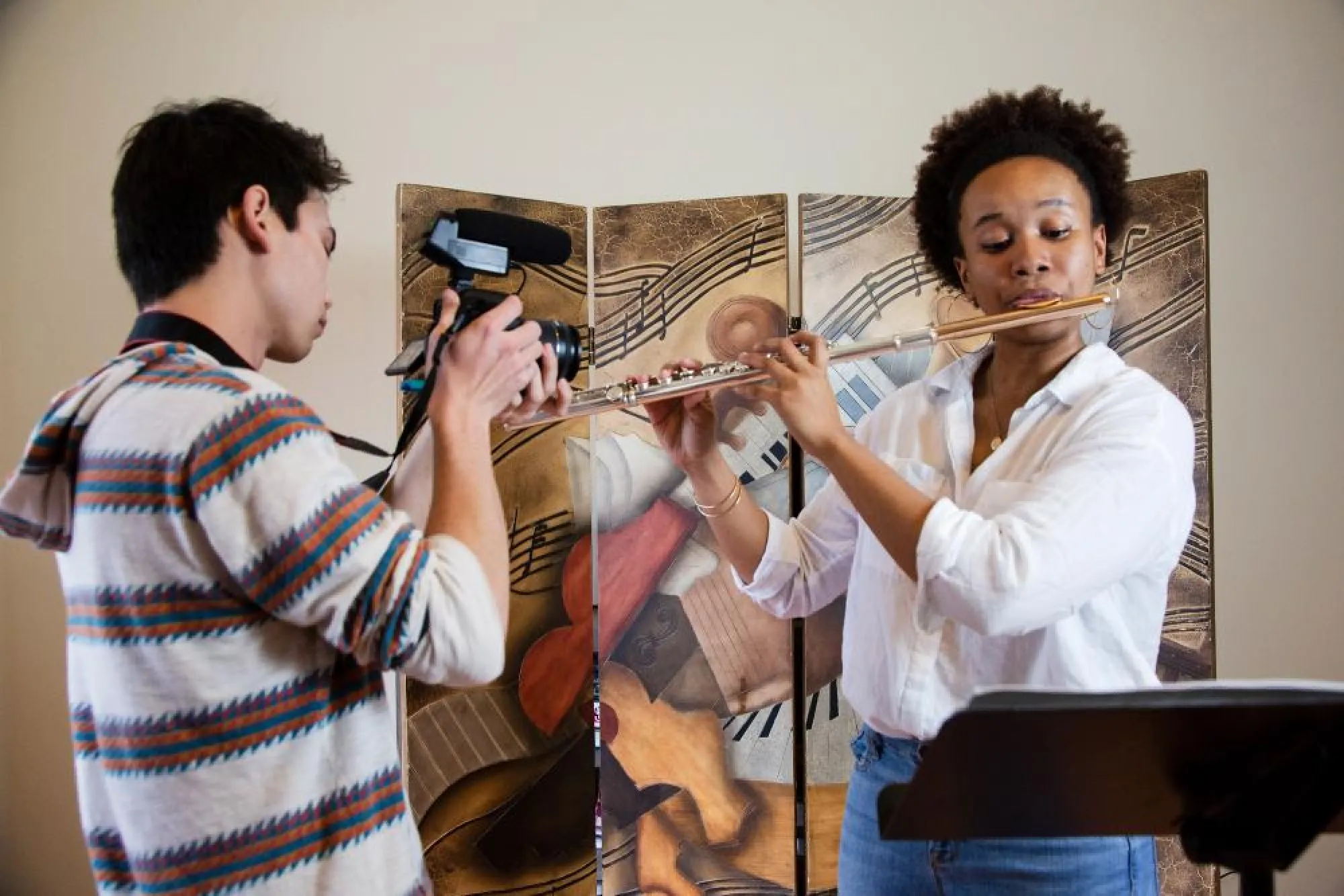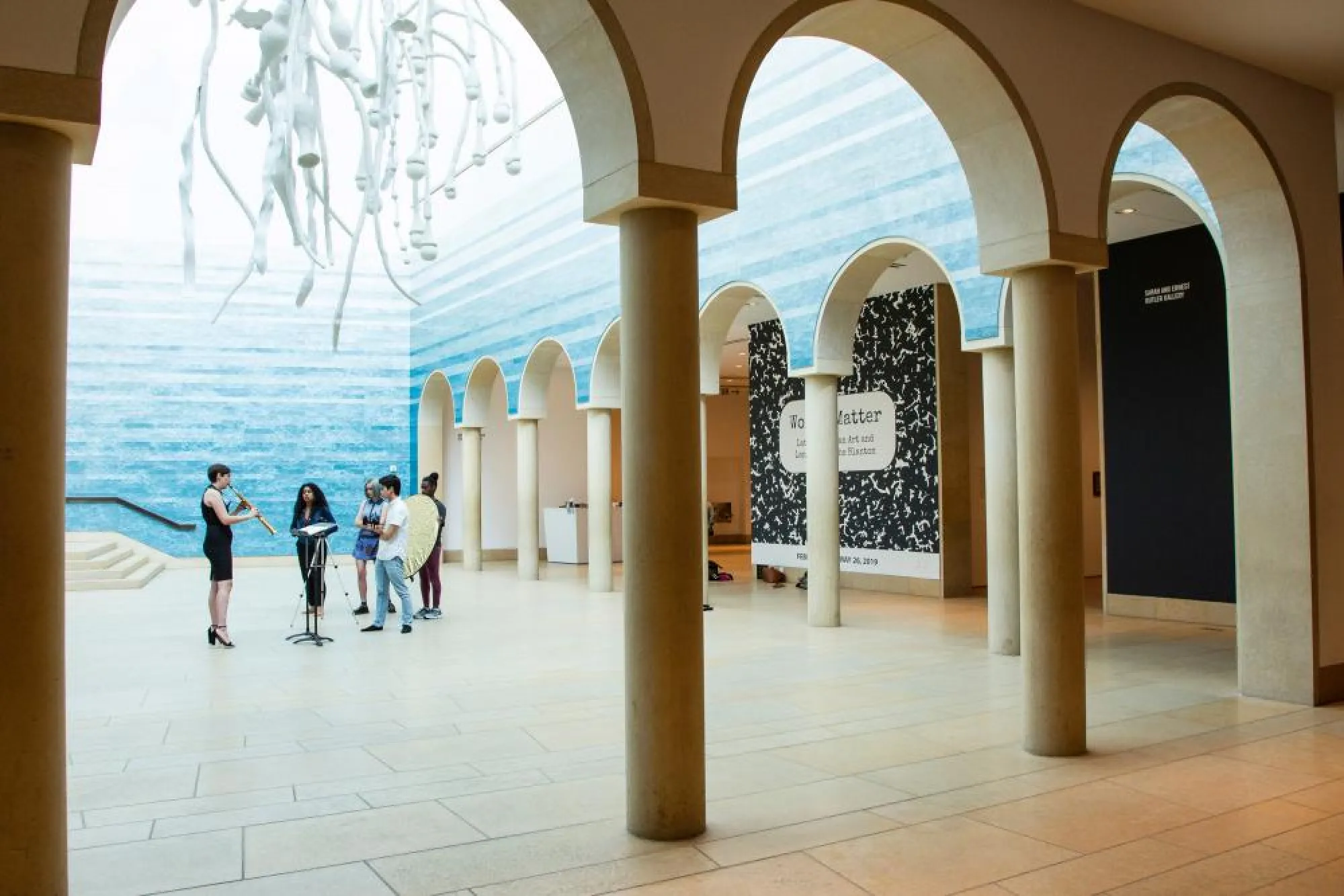A Work In Progress

Classical music has a representation problem. These students want to change that.
by Jen Reel
***
Before Chelsea Daniel was old enough for kindergarten, she was obsessed with Chopin.
She shared this love with her father, who introduced her to classical music with a box set of CDs when she was 4. She played them constantly: Vivaldi, Mozart, Beethoven. But it was Chopin she listened to most nights before falling asleep. To no one’s surprise, Daniel started playing piano at a young age.
Katia Osorio’s calling came later in life. She chose her first instrument in middle school with little fanfare and few options from her band director (“Bassoon or French horn?” “Bassoon, I guess.”) but years later would find inspiration in Monica Ellis, a virtuoso bassoonist in the classical quintet Imani Winds. They were playing works not only from the Western chamber music canon, but pieces inspired by musical traditions of Africa and the Americas, too. Osorio was enamored of the Piazzolla tangos they performed, but when she brought similar pieces to her high school teacher, he said the music wasn’t "serious enough” to play.
Daniel’s detractors were less subtle. She was bullied in high school by students who accused her of being admitted because of her skin color—she was the only black, female classical pianist at the performing arts conservatory—and found little comfort after searching online for others who looked like her, only to come up empty. After she came to The University of Texas and met Osorio at the Butler School of Music in 2016, they became close friends.
“We bonded over sharing our personal experiences, disparities and feelings we thought weren’t shared, weren’t in common, just navigating the classical music industry as women of color,” says Osorio. “There’s not a lot of physical representation of people like us.”
They took a music history class taught by Penny Brandt and discovered that maybe there was more than they had previously been taught. Here, they were learning about people they’d never heard of, composers and musicians whose contributions had been left out of the history books because of their race or gender. Their favorite part of the class was doing their own research and blogging about the stories they found.
“Chelsea and I would go over the top with these assignments,” says Osorio. “We’d turn them in even late sometimes because we just wanted to keep researching and researching and researching, trying to find the blackest and brownest musicians we could find.”
They started imagining ways they could find and share more of these stories with a bigger audience. If they had discovered all of this through class and their own research, imagine what else was out there, and who could benefit from it?
“I started having revelations on what classical music meant and how to define it,” says Daniel. “This whole time I felt like I didn’t belong because of the color of my skin, but then learning about all these people who were neglected in our history textbooks made me realize I actually do belong in this space. How can I and others who look like me be validated and make these stories known to everyone?”
They landed on the idea of creating a series of music videos they could share on YouTube and social media. They would invite performers to play their favorite pieces, maybe even direct people where to find sheet music. (That had been the hardest resource to find and one of the most important for musicians to have.) They would include liner notes about the performers, the pieces they chose and the composers who wrote them. They wanted this to be a one-stop shop for musicians, but also educational and accessible for everyone: concert programmers, teachers, students, music lovers and those who didn’t know they loved it yet. Most importantly, all the pieces would be written and performed by people from marginalized identities.
Their aspirations were big, so they brought in English major Olivia Lynch and Radio-Television-Film major Peyton Young. Lynch, a former Butler student and classically trained violinist, could help design and capture the productions, while Young would be charged with video and photo gathering and editing. It would be the perfect Dream Team. In 2018, they applied for a Rainwater Innovation Grant, part of a newly established $5 million endowment created by the late UT alumnus Richard E. Rainwater (B.A., Mathematics, 1966), a Fort Worth investor and fund adviser. Rainwater wanted students to challenge the usual way of doing things and reach unexpected audiences, thus advancing the field of music in a provocative and productive way. They were awarded $3,500 to set their idea into motion. Since then, they’ve spent countless hours collaborating with musicians, recording performances and producing their new project, Exposure.TV.

***
If it weren’t for the size of Penny Brandt’s hands, she might not be the kind of professor she is today.
Brandt taught herself piano when she was young and worked with a number of instructors as an adult before finding one that was a good fit—but for reasons she wasn’t expecting.

“I realize now it had to do with gender,” says Brandt. “That teacher was the first one who gave me examples of women at the piano, and he really took stock of how small my hands were and introduced me to Alicia de Larrocha, who was a very tiny Spanish pianist. That had a big impact on me.”
Brandt would go on to receive two degrees in music and almost completed her third before noticing that she hadn’t studied or performed a single piece composed by a woman.
While pursuing a doctorate in musicology, she started a research project on Ottorino Respighi, an Italian musician famous for his orchestral poems. It was then that she happened upon a memoir by Elsa Olivieri Sangiacomo Respighi, an Italian pianist, singer and composer of Mexican heritage who was also married to Ottorino. Brandt found Sangiacomo Respighi’s story compelling and presented her case for conducting serious research on this little-known musician.
“It was a light-bulb moment for me when I brought this to my professors and they said, ‘No, you can’t do this,’” says Brandt. “‘If you’re going to write about a woman, then you’re going to have to take gender courses and learn all this feminist theory.’ I thought, ‘What? I didn’t have to learn about gender to write about Stravinsky.’ So that began my uphill battle.”
Brandt shifted gears and went to work. She took the courses and received a certificate in Women, Gender and Sexuality Studies, became the artistic director of the Women Composers Festival of Hartford, wrote a 253-page dissertation on Sangiacomo Respighi, taught graduate level “Women in Music” courses and earned a Ph.D. in music theory and history in 2017 from the University of Connecticut. She came to Austin after her husband accepted a faculty position in the Butler School’s Collaborative Piano program. Distinguished Teaching Professor of Musicology and Associate Dean Andrew Dell’Antonio recommended Brandt to step in and teach the spring 2018 Music History II class after Professor Elliott Antokoletz, who had taught the course for many years, suddenly and unexpectedly passed away just weeks before the start of the semester. Brandt combined the existing syllabus with one she used at UConn to teach the course. She covered 200 years of music with the students, including Daniel and Osorio, focusing on artists from historically underrepresented groups that can be found in the most recent textbooks and those discovered through her and others’ research. She now teaches courses in the college’s Arts Management and Administration program, helping students understand effective fundraising and organization for greater equity in the arts.
***
Comprehensiveness has always been a myth in classical music history. It’s impossible to know and share every story, but whose stories do we tell and why? Only in recent years has there been a growing pushback to the lack of diversity in our traditional history and the narratives used to justify it: that most women and people of color either weren’t producing this music, or weren’t creating it at a level worthy of canon-greatness. Many scholars, including Brandt, have dug deeply and widely to find the works of people both overlooked and undermined. They share their research in classrooms, papers and textbooks to not only exalt these stories, but also to focus a critical eye on the political, social and socioeconomic factors of those periods that decided opportunity and legacy. When Brandt reviews the 19th century in her classrooms, a time of grand operas in France and the famous Bel Cantos of Italy, she doesn’t shield students from the United States’ popular entertainment of the day, minstrels.
“A lot of people just choose to not teach that,” says Brandt. “It’s not just about representation. You have to teach minstrelsy too. You have to teach students this also is part of our legacy and our music, and some of the songs you learn as kids come from this tradition.”
Since 2017, the Butler School has made substantial changes to the courses in the curriculum that focus on the history and social context of music. These changes extend to every level, beginning with a new course called Music and Culture that is designed for all first-year music students. The intent is to get them thinking more deeply about issues in the music field, from politics and identity to copyright and creativity, from privilege and opportunity to colonialism and its effects on culture, and the ethics of many kinds of performances. The curriculum is designed to create a foundation and context for students as they build their education and careers in music.
“Our students are the future of musical creativity,” says Dell’Antonio. “They deserve to be treated seriously as cultural influencers, and because of this, they deserve to wrestle with the complexities of our past, the nuances of our present, and our collective responsibility toward creating a more just and inclusive future.”

***
It’s Monday at the Blanton Museum of Art in Austin, and although its doors are closed to visitors, the sound of a soprano saxophone echoes through its space. Butler student Sarah Hetrick is performing “Tourmaline,” a song written by composer and art advocate Alexandra Gardner, for an audience of four: Osorio, Daniel, Lynch and Young. Together they’re documenting Hetrick’s performance against the blue backdrop of the Blanton’s “Stacked Waters” installation. Sarah is a graduate student in Music Performance and founder of the Female Saxophonist Competition. She’s also the third person the crew has recorded.
“I was especially interested in working with this project because their goal isn’t to promote otherness,” says Hetrick. “What they’re doing is highlighting deserving artists in an everyday context to normalize a cultural value system that prioritizes diversity.”
It’s navigating this thin line—between not defining artists by their race or gender, while honoring what it means for someone like them to be seen and heard—that is at the heart of their project. And they’ve found a like-minded institution, created by a Butler School alumnus, that is helping to support their work.
Rob Deemer (D.M.A., Music, 2005) is a professor at State University of New York at Fredonia and the director of the Institute for Composer Diversity, an organization that promotes underrepresented living composers. The institute focuses on concert programming and has cataloged nearly 4,000 composers and their works into searchable databases—a tool to encourage equal and equitable access for their works to be performed and commissioned. After hearing about Exposure.TV from Brandt, who works as head of development for the institute, Deemer asked the students whether he could add Exposure.TV to the institute’s website.
“I’ve always wanted to be able to have a video presence in some form or fashion with this, and when I saw the folks down at UT doing this, I thought, ‘Wow! This is totally in line with what we’re doing.’”
Deemer and the institute also focus on education to address barriers for future composers, something he lauds the Exposure team’s project for as well.
“Students, especially K-12, don’t see composers of color, or composers who are women, very much,” says Deemer. “If they aren’t hearing music written by someone like them, then it’s much more difficult for them to imagine trying it themselves. So you get this effect of self-censorship even before they’re censored by the systems in place.”
Understanding the context of these systems and their effects, then creating something to help change those systems for current and future generations, is progress. Daniel, Osorio, Lynch and Young are all seniors this fall and are mindful of Exposure.TV’s survival after they graduate, but they have strong supporters who’ve shown vested interest in the project.
“It’s inspired me to keep going, and I’ve thought, ‘When I go away next year, can I send a recording to add to the database? Can I keep contributing to this project after I leave UT?’” says Zoe Cagan, a flutist and recent graduate of the Butler School. Cagan was the first person to be recorded for the Exposure.TV series and chose to play “Tuhuayo,” a piece written by flutist Daniel Cueto. The piece is named after a Peruvian jungle bird and serves as a mindful metaphor for Exposure.TV’s mission.
While Western composers have ingrained the image of dainty, agile birds with the flute, creating pieces that have perpetuated the trite comparison for centuries, Cueto instead chooses to embody the tuhuayo, a bird that rarely flies and spends most of its life on the ground, even laying its eggs on the forest floor. “Tuhuayo” pushes the flute to its full, artistic capabilities and implores us to envision more than one kind of bird when we hear its music.
“The actual gift and emotions and stories behind music are things that always felt special to me, and I’d have to remind myself of that anytime anyone said anything about my playing, or who I am,” says Daniel. “Having this greater purpose, of wanting to share music I think needs to be shown, has reinforced my reasoning for doing what I do every day.”
“It’s true,” says Osorio. “You can’t make progress if this doesn’t exist, and this can’t exist if you don’t work to make progress.
***
Visit Exposure.TV's Instagram, Facebook and YouTube channels, and watch their first reel, "Why did we start EXPOSURE?"

